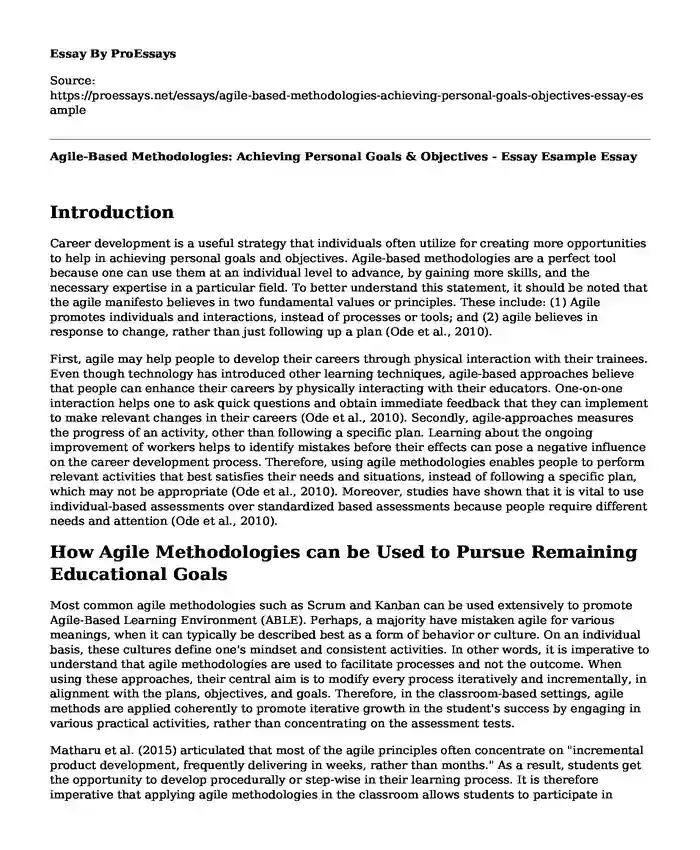Introduction
Career development is a useful strategy that individuals often utilize for creating more opportunities to help in achieving personal goals and objectives. Agile-based methodologies are a perfect tool because one can use them at an individual level to advance, by gaining more skills, and the necessary expertise in a particular field. To better understand this statement, it should be noted that the agile manifesto believes in two fundamental values or principles. These include: (1) Agile promotes individuals and interactions, instead of processes or tools; and (2) agile believes in response to change, rather than just following up a plan (Ode et al., 2010).
First, agile may help people to develop their careers through physical interaction with their trainees. Even though technology has introduced other learning techniques, agile-based approaches believe that people can enhance their careers by physically interacting with their educators. One-on-one interaction helps one to ask quick questions and obtain immediate feedback that they can implement to make relevant changes in their careers (Ode et al., 2010). Secondly, agile-approaches measures the progress of an activity, other than following a specific plan. Learning about the ongoing improvement of workers helps to identify mistakes before their effects can pose a negative influence on the career development process. Therefore, using agile methodologies enables people to perform relevant activities that best satisfies their needs and situations, instead of following a specific plan, which may not be appropriate (Ode et al., 2010). Moreover, studies have shown that it is vital to use individual-based assessments over standardized based assessments because people require different needs and attention (Ode et al., 2010).
How Agile Methodologies can be Used to Pursue Remaining Educational Goals
Most common agile methodologies such as Scrum and Kanban can be used extensively to promote Agile-Based Learning Environment (ABLE). Perhaps, a majority have mistaken agile for various meanings, when it can typically be described best as a form of behavior or culture. On an individual basis, these cultures define one's mindset and consistent activities. In other words, it is imperative to understand that agile methodologies are used to facilitate processes and not the outcome. When using these approaches, their central aim is to modify every process iteratively and incrementally, in alignment with the plans, objectives, and goals. Therefore, in the classroom-based settings, agile methods are applied coherently to promote iterative growth in the student's success by engaging in various practical activities, rather than concentrating on the assessment tests.
Matharu et al. (2015) articulated that most of the agile principles often concentrate on "incremental product development, frequently delivering in weeks, rather than months." As a result, students get the opportunity to develop procedurally or step-wise in their learning process. It is therefore imperative that applying agile methodologies in the classroom allows students to participate in assessments after gaining enough background knowledge and skills through fieldwork, most importantly, the Continuous Assessment Tests. For this reason, agile will enable teachers and trainees to prioritize the use of CATs instead of standardized tests offered at the end of learning programs. When one needs to pursue the remaining educational goals, Continuous Assessment Tests (CATs) are the best because they allow learners to make imminent adjustments in case of errors. This promotes confidence and trust among students because they proceed with the course or program when they are sure that they are doing the right thing. Studies have also discovered that students who participate in CATs to become more innovative, inventive, and generally productive in their various fields of specialization (Chan & Thong, 2009). Besides, a worker can continue with career activities, and at the same time, engage in the agile-based learning environment to promote the remaining educational goals.
References
Chan, F. K., & Thong, J. Y. (2009). Acceptance of agile methodologies: A critical review and conceptual framework. Decision support systems, 46(4), 803-814. https://www.sciencedirect.com/science/article/pii/S0167923608002133
Matharu, G. S., Mishra, A., Singh, H., & Upadhyay, P. (2015). An empirical study of agile software development methodologies: A comparative analysis. ACM SIGSOFT Software Engineering Notes, 40(1), 1-6. https://dl.acm.org/doi/abs/10.1145/2693208.2693233
Ode, Å., Tveit, M. S., & Fry, G. (2010). Advantages of using different data sources in the assessment of landscape change and its effect on a visual scale. Ecological Indicators, 10(1), 24-31. https://www.sciencedirect.com/science/article/pii/S1470160X0900140X
Cite this page
Agile-Based Methodologies: Achieving Personal Goals & Objectives - Essay Esample. (2023, Oct 30). Retrieved from https://proessays.net/essays/agile-based-methodologies-achieving-personal-goals-objectives-essay-esample
If you are the original author of this essay and no longer wish to have it published on the ProEssays website, please click below to request its removal:
- Research Paper Sample: The Effect of Coffee on Student Performance
- Ethical and Moral Dilemma of a Defense Lawyer Essay
- Essay Example on Unraveling the Fundamentals of Educational Methods
- Essay Example on UNLV UULOs: A Guide to Successful Undergraduate Learning
- Essay Example on the Art of Being a Great Student Leader: My Journey of Motivating Others
- Essay Sample on Criminal Justice Info Literacy: Recognizing, Evaluating, Locating & Managing Sources
- Essay Sample on Electronic Addiction







